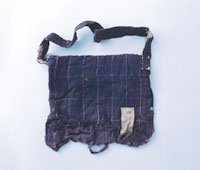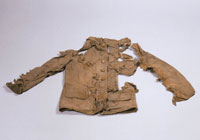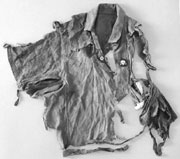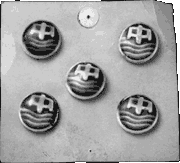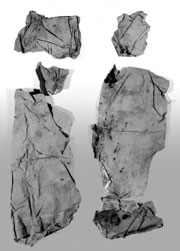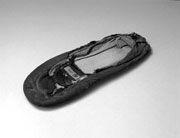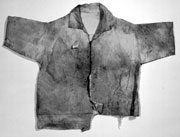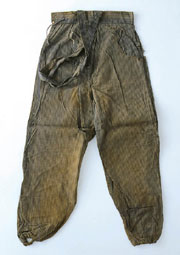 |
| The Suffering of Mobilized Students |
| At 8:15 a.m., August 6, 1945, the world's first atomic bomb was dropped. Students in Hiroshima assigned to mobilization tasks that day, some 7,200-over one in four-fell victim to the atomic bombing. Many burned in the raging fires. Some watched their classmates die. Some overcame their injuries to flee through the mayhem. Those working near the hypocenter witnessed the spreading conflagration and turmoil. But the most extreme horror was experienced by students sent out to demolish buildings in five inner city locations. Of the roughly 8,200 students mobilized for this work, over 5,900 perished. |
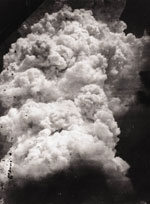 |
25/The dropping of the atomic bomb
August 6, 1945 Looking from the Hiroshima Army Ordnance Supply Depot (Kasumi) at the sky over the hypocenter Photo by Toshio Fukada Courtesy of the Association of the Photographers of the Atomic Bomb Destruction of Hiroshima | ||
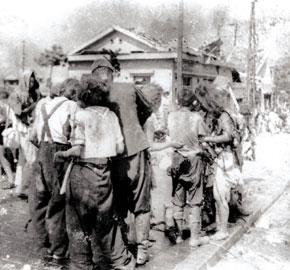 26/Mobilized students receiving emergency care About 11:00 a.m., August 6, 1945 West end of Miyuki Bridge (Senda-machi) Photo by Yoshito Matsushige Courtesy of the Association of the Photographers of the Atomic Bomb Destruction of Hiroshima Three hours after the atomic bombing, the injured gathered at Miyuki Bridge (2,300 meters from the hypocenter) and received emergency treatment consisting of oil on their burns. Students from Hiroshima Girls' Commercial School, who had been mobilized to work at the Hiroshima Savings Bureau, and students of the Hiroshima Municipal Junior High School, who had been helping demolish buildings, are standing in line. Both sides of the bridge were filled with crouching burned and injured students. |
|||
 |
November 1945 Tenjin-machi, Zaimoku-cho, Nakajima-shin-machi, Kako-machi (Nakajima-cho, Kako-machi) In the Prefectural Office area, 400m to 1,100m from the hypocenter, 1,891 students from 11 schools, were mobilized to demolish buildings. A full 1,821 (96%) of them died. The first-year students of Second Hiroshima Prefectural Junior High School were standing at attention at the edge of the Honkawa River. The first- and second-year students from First Municipal Girls' High School had just completed morning assembly and started work. They were all virtually wiped out, so transformed that their bodies were unrecognizable. |
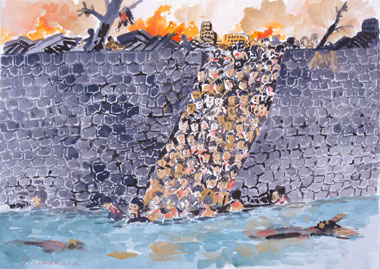 27/Students rushing for the river August 6, 1945 Honkawa River Drawing and text by Yoshio Takahara "All mobilized students on task at that moment were thrown by the blast and burned by the heat wave. They all tried to escape into the Honkawa River, which carried off the dead." |
 28/Corpses swollen like balloons filled the river. About 7:00 a.m., August 7, 1945 Looking downstream of the Honkawa River from the Aioi Bridge Drawing and text by Kyoichi Wakimoto "All corpses were swollen like balloons, their genders indistinguishable. Virtually naked and turned all colors of the spectrum, they floated on the surface. Bridge supports blocked the corpses from flowing downstream." |
 29/Journal of First Municipal Girls' High School Courtesy of Hiroshima Municipal Funairi High School This journal records the disaster from the day of the bombing for approximately three months. It notes the damage done to the school, the search for missing students, and other activities. The surviving teachers lived for one week after the bombing in the school's bomb shelter. They wrote this journal while performing their other services. First Municipal Girls' High School suffered nearly total annihilation. Of the 544 first- and second-year girls who were out helping to demolish buildings near the Prefectural Office, 541 were killed by the bomb. |
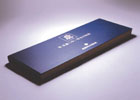 30/Record of the first-year students at Hiroshima Second Junior High School Donated by Hiroshima Telecasting Co., Ltd. This record of a bereaved family was featured in a documentary drama produced by Hiroshima Telecasting in 1969. Information about 209 first-year students at Second Hiroshima Prefectural Junior High School was handwritten by bereaved family members. The 321 students who were engaged in building demolition near the Prefectural Office were standing on the riverbank for roll call. All were killed by the bomb. |
|
|
|||||||||||||
 |
In the Dobashi area, 600m to 900m from the hypocenter, 1,530 students from 11 schools were mobilized to demolish buildings. Of these, 1,264 (83%) died. The first-year students of First Hiroshima Prefectural Girls' High School had begun picking up the thrown roof tiles. The first- and second-year students of Hiroshima Municipal Junior High School had laid down their things and were preparing to start work. Even the ones who somehow dragged their burnt and peeling bodies westward to Koi perished one after the next. |
 35/Dead junior high students About 4:00 p.m., August 9, 1945 Dobashi area Drawing and text by Hidehiko Okazaki "The junior high school students demolishing buildings were annihilated. Countless charred gaiters lay on the ground facing the riverbank, suggesting a horrific spectacle of students throwing themselves into the river as gaiters flamed and fell off their legs. The lined up corpses are those of female students." |
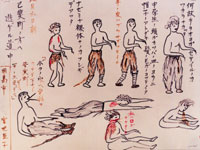 36/Junior high students fleeing bare-chested Morning, August 6, 1945 Fleeing towards Koi Drawing and text by Tomiko Miyaji "I did not know why they held their arms in front of them. Only the hair sheltered under the caps typically worn by junior high students remained on their heads in a bowl shape. The skin on their arms hung loose. Strangely, they were all naked." |
|
Diaries of first-year students at First Hiroshima Prefectural Girl's High School
Donated by Noriko Ueda, Michiko Umekita, Takatoshi Kumamoto, Setsuko Yamada Courtesy of Naoya Ishido, Yoko Fukumori Of the 223 first-year students at First Hiroshima Prefectural Girl's High School who were demolishing buildings near Dobashi, none survived. These diaries that they had submitted to their teachers were given to the girls' parents. They describe daily life at the girls' school. Some are written with fountain pens, others with pencils. Some are covered with decorative paper. The content is equally individualized. |
||||||||||||||||||||||||||
 |
 |
|||||||||||||||||||||||||
37/
|
||||||||||||||||||||||||||
|
38/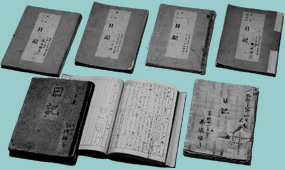 |
|||||||||||||||||||||||||
|
|
|||||||||||
 |
In the City Hall area, roughly 1,000m from the hypocenter, 2,331 students from 12 schools were mobilized to demolish buildings, of which 1,749 (75%) died. The first- and second-year students of Yamanaka Girls' High School had just completed taking attendance and were already at work. The first-year students of First Hiroshima Prefectural Junior High School were scattered over the area, making piles of wooden boards and hauling logs. Virtually all those whose injuries permitted them to escape the area collapsed further up the road or at their refuge sites. Only a few survived. |
 |
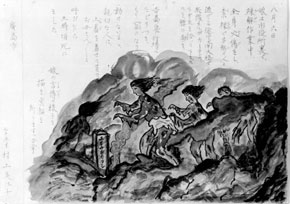 |
|
|
42/A concrete fence collapsed and killed mobilized students.
About 9:00 a.m., August 10, 1945 Behind City Hall (Kokutaiji-machi) Drawing and text by Misako Murakami "A concrete fence toppled, instantly killing members of the Volunteer Corps and mobilized students. My daughter, who was working here, disappeared. I called her till my voice dried up. I called and called but she never returned." |
43/Burned girl students fleeing
August 6, 1945 Near Minami-ohashi Bridge Drawing and text by Misako Murakami "While demolishing buildings behind City Hall, my daughter was burned over her entire body. Naked, she fled with a large group of people. On the way, a soldier found a curtain fragment and wound it around her body. By the time a kind person covered her with his or her own jacket, she was blind and unable to move. Crying, 'Mother, mother!' she died around 3:00 p.m." |
|
|
|||||||||||||
|
|
|
|
|||||||||||||
 |
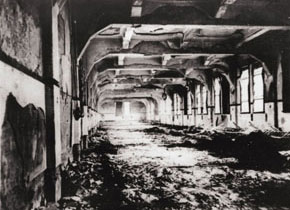 52/Hiroshima Central Telephone Bureau Autumn 1945 Hiroshima Central Telephone Bureau, second floor operators room (Fukuro-machi) Photo by U.S. Army Of the roughly 110 third-year students from Shintoku Girls' High School mobilized to work at the Hiroshima Central Telephone Bureau, 540 meters from the hypocenter, 92 died. The students were working as operators or handling office tasks. The blast pierced them with shattered glass and threw furniture on them, instantly killing or gravely injuring most of them. |
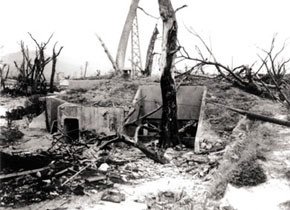 53/Chugoku Military District Headquarters Autumn 1945 Chugoku Military District Headquarters, underground communications office (Moto-machi) Photo by U.S. Army Of the roughly 90 third-year students of Hijiyama Girls' High School mobilized to work at the Chugoku Military District Headquarters, roughly 790 meters from the hypocenter, 67 died. In the underground communications office used as an army strategic communications office, students were sending and receiving encoded communications and issuing warnings. A girl student who escaped harm because she was working in the underground office notified other command headquarters of Hiroshima's destruction. |
|
|
|||||||||||||
 58/Weeping girl students fled the schoolyard. Immediately after the A-bomb explosion, August 6, 1945 Second National School (Minami-kan-on) Drawing and text by Sakae Maeda "The blast from the atomic bomb pierced the mobilized students' bodies with pieces of glass and wood. Drenched with blood, they ran crying out into the schoolyard. There was no way to treat their burns or stop their bleeding. I brought out a bucket with a small amount of cooking oil and used a rag to apply a little to each face." |
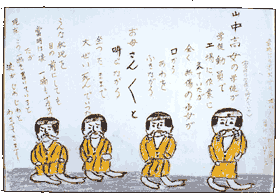 59/Young girls who died screaming, "Mother!" Drawing and text by Nobuko Nakagawa "Many students from Yamanaka Girls' High School were at their factory mobilization site. Girls who appeared completely uninjured were foaming at the mouth. Many sat down, cried, 'Mother! Mother!' and died. I witnessed this scene without shedding a tear, but while drawing this picture, the tears came." |
| Mobilized Students -The Lost Tomorrows of the Students- Introduction Schools Stained the Color of War The Start of Student Mobilization Building Demolition Amplified the Tragedy The Suffering of Mobilized Students Looking for Children Reopening in the Burnt Ruins Monuments to the Students Return to TOP |

